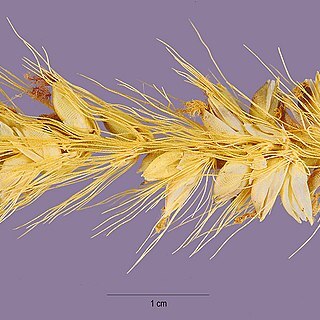Tufted perennial 500-1200 mm high; rhizome stout, very well developed, often much branched; basal sheaths robust, very dark brown; basal leaves few; culm node hairy. Leaf blade 100-550 x 4-10 mm, expanded, tapering to a fine point, mostly conspicuously narrowed at base, densely hairy or glabrous. Inflorescence 20-160 mm long, cylindrical, spike-like; each spikelet or cluster subtended by up to 10 bristles; bristles 5-10 mm long, rather coarse, scabrid, straw-coloured, apices slightly thickened, usually dark purple. Spikelet 3.5-5.0 mm long; glumes apices distinctly dark coloured; lower glume 3-nerved; lower lemma deeply grooved; upper lemma finely rugose, tip with a distinct dark patch; anther 2.0-2.5 mm long.
Perennial, rhizomatous (rhizome very well developed and much-branched), or tufted (with few basal leaves), up to 1.2 m high. Leaf blades 100-550 mm long, 4-10 mm wide. Basal plant parts very robust and dark-coloured. Culm nodes hairy. Spikelets 3.5-5.0 mm long. Panicle spike-like, usually cylindrical to tip; spikelets with distinct dark tips; lower glume 3-nerved.
Perennial; up to 1.2 m high; rhizome very well developed and much branched; or tufted with few; basal leaves. Culm nodes hairy; basal sheaths very robust and dark brown. Leaf blades 100-550 x 4-10 mm. Flowers: panicle spike-like; usually cylindrical at apex; spikelets 3.55.0 mm long; spikelets with distinct dark apices; upper glume (5)7-9(-11)-nerved.
Panicle 2–15 cm. long; bristles 5–10 mm. long, slightly clavate and glutinous at the apex.
Culms 20–100 cm. high, the nodes pubescent and basal sheaths chocolate brown.
Tufted perennial from a short rhizome.
Otherwise like S. incrassaia.
Spikelets 3–4 mm. long.

